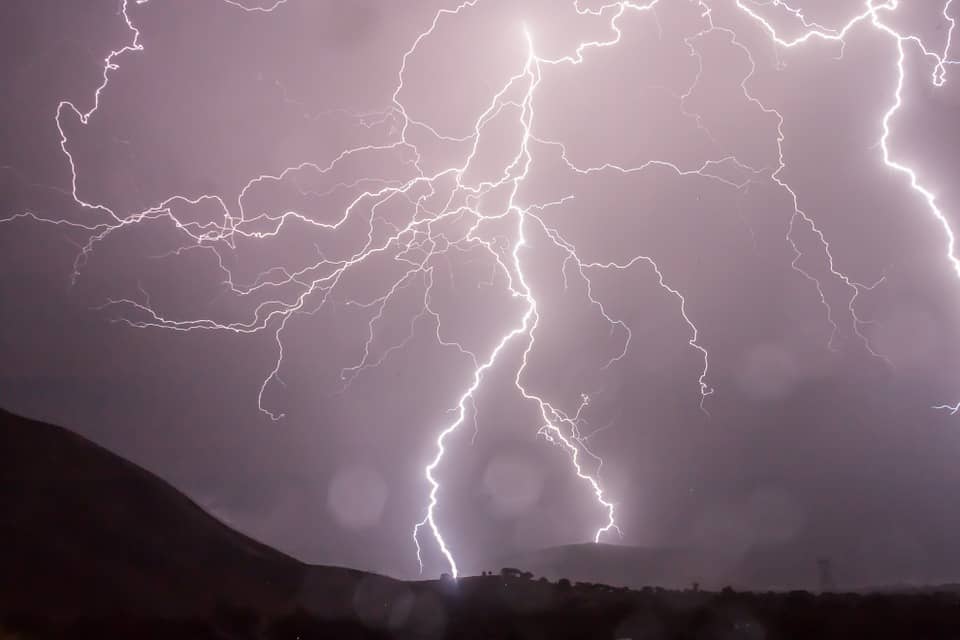I personally don’t let Mother Nature stop my desire to ride, neither do a lot of people. Even when the rain pours and lightning starts, if I’m in the mood to ride, I will ride. I’ve even ridden a full five hours in the rain start to finish, with lightning. But is it really safe to ride motorcycles in a lightning storm?
Riding in the rain, as I’ve found out, is actually fun. It’s a different experience from riding in dry sunny weather with the confidence you get from grip and vision, but riding in the rain comes with its own appeal. Click here for 16 Tips for Riding a Motorcycle in the Rain. That being said, riding in the rain with the presence of lightning or thunder is a whole different story.
Is it safe to ride in a thunderstorm?
No, it’s not safe to ride during a thunderstorm/lightning storm. Lightning loves hitting metal which makes motorcycles lightning magnets. Unlike a car, where you have a protective metal cage around you that works as a sort of Faraday cage when you get hit by lightning, a motorcycle has the rider exposed. But despite what you’re doing, it’s never really ‘safe’ to do anything outside during a lightning storm.
It’s even more dangerous if you’re riding in a flat open area. Lightning wants to find the quickest route to the ground and will, therefore, hit the tallest thing around. Riding a motorcycle in a flat open road with a lightning storm brewing is just a bad day waiting to happen.

What to do if you get caught in a thunderstorm?
There are instances where you start your ride and the weather takes a sudden turn. This has happened to me too. I start the ride at a sunny 7 a.m. and a few hours late I’m wet and riding for my life. I’ve been caught in a thunderstorm as well but luckily the roads where I’m from have lots of tall structures and trees. The risk is still present but I’ve been pretty lucky so far.
Regardless, here are a few things I always keep in mind while riding and I think some riders could benefit from sharing this knowledge.
Find shelter
At the first sign of lightning or thunder, don’t turn around the other direction. Lightning can come from anywhere. You can get hit even before the rain starts so if you spot lightning or hear thunder, seek shelter immediately and wait. It’s recommended that you should wait a good 30 mins after the last lightning strike or thunderclap before resuming the ride.
Don’t be the tallest point
If you can’t find shelter immediately, try to stay away from flat open spaces. As mentioned earlier, lightning wants to hit anything that pops out of the average height. That’s why lightning strikes on trees, lamp posts, and electric towers are common. The usual motorcycle with the rider on top is actually taller than your average car so if you’re caught in a thunderstorm, look for an area with buildings or structures that are taller than you.
This also means you shouldn’t ride on or near an open area like open roads, roads near beaches, and roads near fields. This also means you should stay away from elevated places like hills, canyons, or bridges.
Find the right shelter.
A single tree might provide shelter from the rain but not from lightning. The same can be said about shelters with metal piping or plumbing. So you may want to stay away from any tents, outhouses, lean-to shelters, or picnic structures as these might attract the lightning. Alternatively, large enclosed concrete structures with no plumbing provide great protection from lightning strikes. Lots of overpasses are actually designed to protect people from lightning strikes and are usually grounded. You’ll be relatively safe if you stay under one. Just make sure to stay away from any metal girdles or ground currents by staying on dry ground.
Avoid ground currents
You can still get electrocuted on your bike even if you weren’t hit by lightning. The ground can actually conduct electricity. Wet ground on a thunderstorm can do this even better. Try to steer away from puddles or avoid standing on wet ground or wet grass when under shelter.
If lightning hits near you, it can still travel underground and conduct itself to your bike and to you. Avoiding large puddles near places where lightning might strike will be safer than just plowing through puddles as fast as you can.
Stay away from metal
Metal is a great conductor for electricity so it’d be ideal if you stay away from metal fences, machinery, construction equipment, and other large or tall metal objects. If you’re in a shelter wide enough, it might also be a good idea to distance yourself from your motorcycle.
This means that you should try to avoid tall metal objects as well. You could be hiding under a small shed but that would still provide little protection if the shed was right next to an electric post, electric tower, a metal lamp post, or even a wooden post.
What happens if you’re struck by lightning while riding?
If you get hit by lightning, all bets are off. Though there are instances of people getting hit by lightning on their bikes and surviving, most incidents result in death. It’s best not to test your luck. If you spot lightning or hear thunder, the best thing to do is still to find shelter and wait for it to pass.
If you’re riding with someone and they get struck by lightning, here are a few things you’d wish you already knew:
- Call for help immediately. Dial your country’s emergency hotline. They will guide you how to handle the situation.
- Move them and yourself to a safer location. Lightning can strike the same place twice.
- If you know how to do it, begin CPR. Lightning strikes can cause cardiac arrest and disrupt the heart’s rhythm. Once it’s safe to start the procedure, do it. Do not stop until the paramedics arrive.
- Do not remove his burnt gear unless necessary. The burnt geat may have stuck itself to the flesh and removing it may result in more injury.
To recap, it is not safe to ride during a thunderstorm. The first thing you should do is to find shelter and wait. Find a shelter that has no or has minimal metal parts. Also, you should stay low and make sure you’re not rising above the average height. If someone you’re with someone who gets struck by lightning, the first thing you should do is to get them to safety, then you should call emergency personnel, and start doing CPR.
